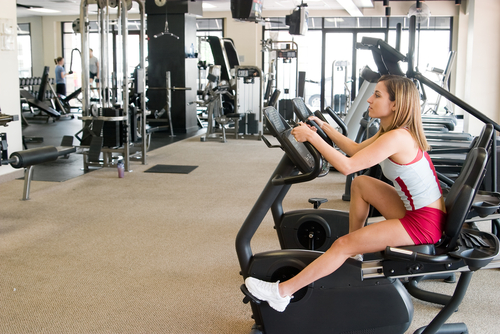
Some athletes believe that a diagnosis of arthritis means the end to their competitive or performance careers, but this is simply not true. In regards to arthritis and sports, athletes living with various joint conditions can continue the activities they love with just a few changes and minor adjustments. Whether an athlete needs to accommodate an arthritic knee, hip, elbow or other body parts, there are safe and effective ways to continue exercising without causing additional damage.
Here is a description of several workout modifications that athletes with arthritis can make to continue playing sports. This article will also cover recommendations for low impact exercise options and types of exercise easy on knees.
Swimming and Rowing Instead of Running and Stair-Climbing
As a general rule, athletes with arthritis benefit from low impact exercise rather than high impact activities.1 However, cardiovascular training is important for performance and also general wellness. For athletes with arthritis, focus on non-weight bearing exercises that utilize large groups of muscles. Swimming, water walking, other aquatic exercises, dancing, elliptical machines, and rowing are great low impact exercises that get the blood pumping and the heart rate up. Some arthritic athletes may benefit from cycling as well.
Choose these types of cardio exercise over running, jogging, or stair-climbing if arthritis symptoms exist in the hips or knees. Also, barre-style exercises are great low impact exercise alternatives to HIIT or CrossFit workouts, which put more strain on the joints.
Partial Resistance Exercises Over Full Range of Motion
Strength and resistance training exercises can help individuals with arthritis strengthen the muscles around their joints and feel less pain during workouts.2,3,4 It is recommended that athletes who have arthritis pain in a specific joint target the muscles groups around that joint in their workouts. However, a well-rounded strength training plan that incorporates all major muscle groups should be practiced overall.
It is appropriate for these athletes to use weight machines, free weights, elastic bands, and their own body weight as part of a resistance training program.5 Start with light weights and fewer repetitions at the beginning of a new training plan.6 It may also be beneficial to reduce the range of motion of certain exercises to protect painful joints.7 For example, partial squats can be performed in place of full squats, and stationary lunges can be performed in place of walking lunges. Modifications like these represent types of exercise easy on knees for arthritis sufferers.
Targeted Stretching Exercises
Stretching is incredibly important for anyone with arthritis, but especially for athletes. Warm-up and cool-down stretches improve flexibility and range of motion through passive movements that lengthen and strengthen muscles.8 Since the hamstrings, calves, and fronts of the shoulders tend to lose flexibility with age, athletes with arthritis should focus on these large muscle groups while stretching. Many athletes use arthritis relief creams like JointFlex to provide immediate and long-lasting relief before and after workouts.
Any Exercise Can Be Modified
It is also important to remember that essentially any exercise can be modified, so athletes shouldn’t feel restricted to the types of workouts they do.9 Arthritis sufferers have good days and bad days, so what works well at the gym on Monday might not work at all on Wednesday.
Any exercise is better than no exercise at all, but it may be necessary to slow down the pace, reduce the weight, switch to low impact exercise or stop exercising for the day if pain worsens with movement. A physician, physical therapist, or personal trainer may be able to provide more specific suggestions about tailoring workouts to an athlete’s abilities and the severity of arthritis symptoms.
REFERENCES FOR LOW IMPACT EXERCISES…FOR ARTHRITIC ATHLETES
1. Winters, C. Fifteen ways to work out with arthritis. Arthritis Foundation. Joint pain. Retrieved October 30, 2018 from https://www.arthritis.org/living-with-arthritis/exercise/workouts/other-activities/workouts-for-arthritis.php.
2. How exercise helps your joints. Arthritis Foundation. Retrieved October 24, 2018 from http://blog.arthritis.org/living-with-arthritis/exercise-benefits-for-joints/.
3. DeVries, C. (2015 July 6). Strength training can crush arthritis pain. Arthritis Health. Retrieved October 30, 2018 from https://www.arthritis-health.com/blog/strength-training-can-crush-arthritis-pain.
4. Strength training is essential for arthritis. Arthritis Foundation. Retrieved October 30, 2018 from http://blog.arthritis.org/living-with-arthritis/strength-training-arthritis/.
5. Strength training for people with arthritis. Arthritis Foundation. Retrieved October 30, 2018 from http://blog.arthritis.org/living-with-arthritis/strength-training-types/.
6. Weight training 101. Arthritis Foundation. Retrieved October 31, 2018 from https://www.arthritis.org/living-with-arthritis/exercise/how-to/weight-training-for-beginners.php.
7. Five weight training tips for people with arthritis. Harvard Health Publishing. Retrieved October 31, 2018 from https://www.health.harvard.edu/staying-healthy/5-weight-training-tips-for-people-with-arthritis.
8. Warm up, cool down and be flexible. American Academy of Orthopaedic Surgeons. Retrieved October 30, 2018 from https://orthoinfo.aaos.org/en/staying-healthy/warm-up-cool-down-and-be-flexible/.
9. Funiciello, M. (2011 February 25). Exercising with arthritis. Arthritis Health. Retrieved October 31, 2018 from https://www.arthritis-health.com/treatment/exercise/exercising-arthritis.
